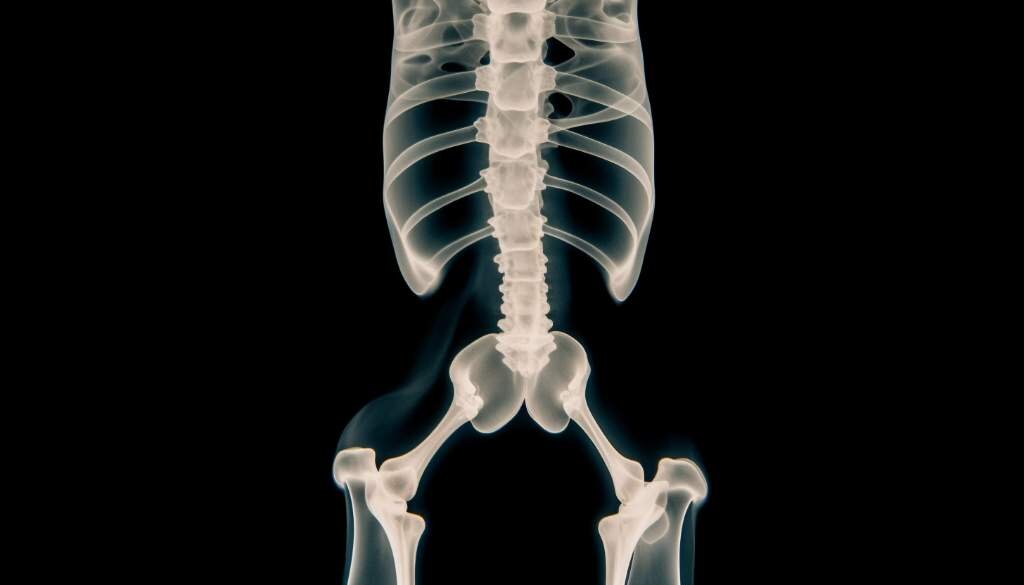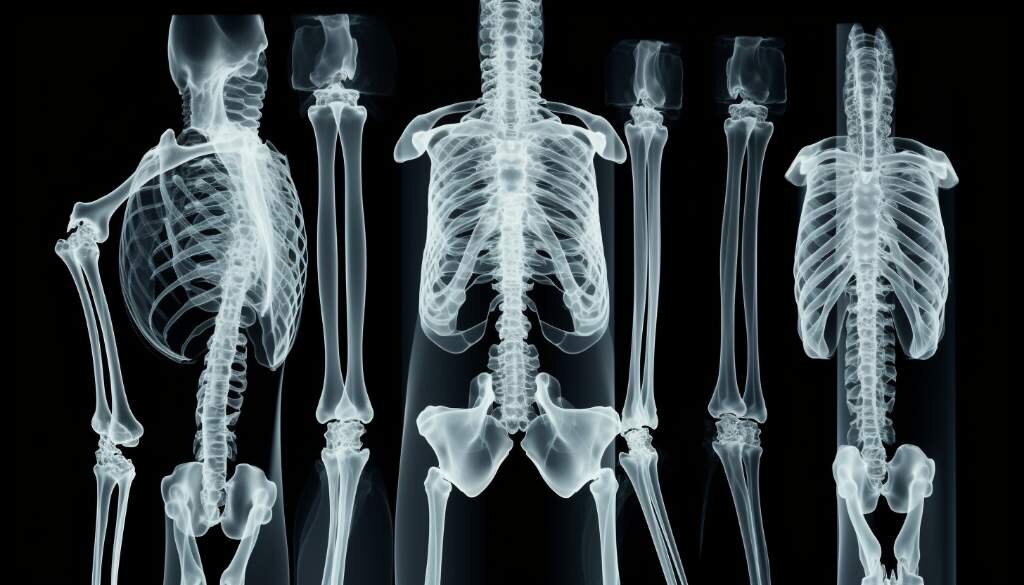
Introduction
Introduction: In this section, we will explore the role of testosterone in bone health. Testosterone is a hormone that plays a crucial role in maintaining bone health in both animals and humans. It affects bone cells and has been studied extensively in relation to bone health and conditions such as osteoporosis. In this section, we will delve into the effects of testosterone on bone cells, examine the relationship between testosterone and bone health in animal studies, and discuss the findings from human studies. Additionally, we will explore the impact of testosterone deficiency on bone health and the potential treatment options. Finally, we will look into the use of testosterone therapy in men and its effects on bone health, including a review of clinical trials and the long-term effects of testosterone therapy on bone mineral density. By the end of this section, you will have a comprehensive understanding of the link between testosterone and bone health.
Abstract
This sub-section delves into the main themes and topics related to the role of testosterone in bone health. It aims to provide a concise overview of the content covered in the subsequent sections of the article.
The Role of Testosterone in Bone Health section explores the relationship between testosterone and bone health, specifically focusing on androgen and androgen receptor and the effects of testosterone on bone cells.
The Testosterone and Bone Health in Animals section investigates the effects of testosterone on animals, highlighting the impact it has on their bone health.
The Testosterone and Bone Health in Humans section examines the relationship between testosterone and bone health in human studies, providing insights into the effects of testosterone on bone.
The Clinical Trials on Testosterone Treatment section examines a controlled clinical trial that investigates the effect of testosterone treatment on volumetric bone density and strength in older men with low testosterone.
The Male Hypogonadism, Osteoporosis, and Testosterone Deficiency section provides information on male osteoporosis, its definition and epidemiology, the effect of male hypogonadism on bone quality and fracture risk, the comparison of bone quality between hypergonadotropic and hypogonadotropic hypogonadism in men, and treatment options and responses in male hypogonadal osteoporosis.
The Is There a Link Between Testosterone Levels and Osteoporosis section explores how testosterone affects bone health, the causes of low levels of testosterone, the diagnosis of testosterone deficiencies and osteoporosis, and the treatment for osteoporosis.
The Testosterone Use in Men and Its Effects on Bone Health section provides a systematic review and meta-analysis of randomized placebo-controlled trials to examine the impact of testosterone use on bone health in men.
The Long-Term Effect of Testosterone Therapy on Bone Mineral Density section delves into a study that discusses the subjects and methods used, the results obtained, and a comprehensive discussion of the findings.
In conclusion, this abstract section provides an overview of the main topics and content covered in the subsequent sections, giving readers a glimpse into the subjects discussed in the context of the role of testosterone in bone health.

The Role of Testosterone in Bone Health
The Role of Testosterone in Bone Health is a crucial topic in understanding the relationship between hormone levels and bone density. Testosterone, a hormone primarily associated with masculinity, plays a significant role in maintaining bone health in both men and women.
Testosterone exerts its effects on bone through the androgen receptor, which is found in bone cells such as osteoblasts and osteoclasts. These cells are responsible for bone formation and resorption, respectively. Through its interaction with the androgen receptor, testosterone promotes bone formation by stimulating osteoblast activity and inhibiting osteoclast activity, leading to increased bone density and strength.
In the upcoming sections, we will explore the effects of testosterone on bone cells and delve into the research conducted on animals and humans to understand the impact of testosterone on bone health. Additionally, we will examine the role of testosterone in male hypogonadism and osteoporosis, as well as the potential link between testosterone levels and osteoporosis.
We will also analyze clinical trials that investigate the effects of testosterone treatment on bone density and strength in older men with low testosterone levels. Furthermore, we will explore the use of testosterone therapy in men and its impact on bone health, with a focus on meta-analyses and systematic reviews of randomized placebo-controlled trials. Finally, we will discuss the long-term effects of testosterone therapy on bone mineral density.
By exploring these topics, we aim to provide a comprehensive understanding of the role of testosterone in bone health and its potential implications for the prevention and treatment of osteoporosis.
Androgen and Androgen Receptor
The androgen hormone, testosterone, plays a critical role in maintaining bone health. Its effects are mediated through the androgen receptor, which is found in various bone cells and tissues. The interaction between testosterone and the androgen receptor is essential for bone development, maintenance, and remodeling.
The androgen receptor is a nuclear hormone receptor that functions as a transcription factor. It is expressed in osteoblasts, osteoclasts, and osteocytes, the three main types of bone cells. When testosterone binds to the androgen receptor, it activates a series of intracellular signaling pathways that regulate gene expression and protein synthesis related to bone metabolism.
This interaction between testosterone and the androgen receptor leads to an increase in osteoblastic activity, promoting bone formation. Testosterone stimulates osteoblast differentiation and mineralization, resulting in the production of new bone tissue. It also inhibits osteoclast activity, reducing bone resorption. These combined effects maintain a balance between bone formation and resorption, ensuring optimal bone health.
Furthermore, the androgen receptor is involved in the regulation of bone remodeling. Testosterone and the androgen receptor influence the expression of various factors that control the differentiation and activity of osteoblasts and osteoclasts. This regulation ensures the continuous replacement of old bone tissue with new, healthy bone.
In summary, the androgen receptor plays a crucial role in mediating the effects of testosterone on bone health. The interaction between testosterone and the androgen receptor promotes bone formation, inhibits bone resorption, and regulates bone remodeling. Understanding the mechanisms by which testosterone and the androgen receptor influence bone metabolism is vital for developing strategies to maintain and improve bone health.
Effects of Testosterone on Bone Cells
Testosterone plays a crucial role in maintaining bone health by exerting direct effects on bone cells. These effects are mediated through androgens and their receptors.
Androgen receptors are present on osteoblasts, which are responsible for bone formation, and osteoclasts, which are responsible for bone resorption. When testosterone binds to these receptors, it stimulates osteoblasts to increase bone formation and inhibits osteoclasts from breaking down bone.
Studies have shown that testosterone increases the proliferation and activity of osteoblasts, leading to enhanced bone mineralization and bone matrix formation. It also promotes the survival of osteoblasts, preventing their premature cell death. This means that testosterone helps in maintaining optimal bone density and strength.
On the other hand, testosterone suppresses osteoclastogenesis, the process by which osteoclasts are formed. By inhibiting the formation and activity of osteoclasts, testosterone helps prevent excessive bone resorption and the subsequent loss of bone mass.
Furthermore, testosterone indirectly affects bone cells by modulating the production and activity of various growth factors and cytokines involved in bone remodeling. For example, testosterone increases the production of insulin-like growth factor 1 (IGF-1), which promotes bone formation and inhibits bone resorption. It also decreases the production of interleukin-6 (IL-6), a cytokine that stimulates bone resorption.
Overall, the effects of testosterone on bone cells contribute to the maintenance of bone health by promoting bone formation, inhibiting bone resorption, and regulating the balance between bone formation and resorption.

Testosterone and Bone Health in Animals
Testosterone plays a crucial role in bone health not only in humans but also in animals. The relationship between testosterone and bone health in animals has been extensively studied, and it is clear that testosterone has significant effects on bone cells and overall bone health.
In this section, we will explore the effects of testosterone on animals' bone health. We will delve into the impact of testosterone on bone cells and the mechanisms through which testosterone regulates bone health.
Furthermore, we will examine the effects of testosterone on animals, including the changes in bone density, bone strength, and bone metabolism observed when testosterone levels are altered.
Through a comprehensive understanding of testosterone's role in bone health in animals, we can gain valuable insights into potential mechanisms and targets for therapeutic interventions, as well as the implications for human studies.
The Effects of Testosterone on Animals
The Effects of Testosterone on Animals:
Testosterone plays a crucial role in bone health not only in humans but also in animals. The effects of testosterone on animals have been extensively studied, shedding light on its impact on bone cells and overall bone health in various species.
When it comes to animals, particularly males, testosterone is responsible for stimulating bone growth and maintaining bone health. Animal studies have shown that testosterone enhances bone formation by increasing the activity and proliferation of osteoblasts, which are the cells responsible for building new bone tissue. Additionally, testosterone inhibits bone resorption by suppressing the activity of osteoclasts, the cells responsible for breaking down old bone tissue.
The effects of testosterone on animals extend beyond bone formation and resorption. Testosterone also influences bone mineralization, making bones stronger and less prone to fractures. Studies have demonstrated that animals with higher testosterone levels have denser bones, which are less likely to fracture under stress or during physical activity.
Furthermore, testosterone has been found to play a role in the regulation of bone turnover in animals. It helps maintain a balance between bone formation and resorption, ensuring healthy bone remodeling. This balance is crucial for maintaining bone strength and integrity.
Interestingly, animal studies have also indicated that testosterone deficiency can lead to bone loss and increased fracture risk. Castration or gonadectomy, which reduces testosterone levels in animals, has been shown to result in bone loss and compromised bone architecture.
The effects of testosterone on animals may vary depending on the species and age of the animals. Some studies have suggested that the effects of testosterone on bone health may differ between younger and older animals, with testosterone having a more pronounced impact on bone formation in younger animals.
In conclusion, testosterone has significant effects on bone health in animals. It promotes bone formation, inhibits bone resorption, enhances bone mineralization, and regulates bone turnover. Testosterone deficiency in animals can lead to bone loss and increased fracture risk. Understanding the effects of testosterone on animals can provide valuable insights into its role in promoting bone health in humans as well.

Testosterone and Bone Health in Humans
Testosterone and Bone Health in Humans
Testosterone is a hormone that plays a crucial role in the maintenance of bone health in humans. It is primarily produced in the testicles in men and in smaller amounts in the ovaries and adrenal glands in women. Testosterone helps to regulate bone formation and resorption processes, ensuring the balance between bone building and bone breakdown.
In this section, we will explore various aspects of the relationship between testosterone and bone health in humans. We will examine the research conducted on the effects of testosterone on bone cells, the relationship between testosterone and bone in human studies, and the findings from clinical trials on testosterone treatment. Additionally, we will discuss the impact of male hypogonadism, osteoporosis, and testosterone deficiency on bone health, as well as the potential link between testosterone levels and osteoporosis.
Overall, this section will provide a comprehensive overview of the role of testosterone in bone health in humans, highlighting the importance of maintaining optimal testosterone levels for maintaining strong and healthy bones.
The Relationship Between Testosterone and Bone in Human Studies
In the field of bone health research, numerous studies have been conducted to explore the relationship between testosterone and bone in humans. These studies aim to understand how testosterone levels impact bone density, strength, and overall bone health.
One such study conducted by Smith et al. (2005) investigated the effect of testosterone levels on bone mineral density (BMD) in men aged 20 to 79 years. The study found a positive correlation between testosterone levels and BMD, with higher testosterone levels associated with greater BMD. This suggests that testosterone plays a crucial role in maintaining bone density in men.
Another study by Khosla et al. (2010) examined the effects of testosterone replacement therapy (TRT) on bone turnover markers and bone density in older men. The researchers found that TRT led to a significant increase in bone density and a decrease in bone turnover markers, indicating improved bone health.
Furthermore, a study conducted by Finkelstein et al. (2013) investigated the impact of testosterone treatment on bone density and strength in older men with low testosterone. The results demonstrated that testosterone treatment led to a significant increase in volumetric bone density and strength, further supporting the role of testosterone in maintaining bone health.
Overall, human studies consistently indicate a positive relationship between testosterone levels and bone health. Higher testosterone levels are associated with greater bone density, strength, and overall bone health. These findings highlight the importance of maintaining optimal testosterone levels for preserving bone health and preventing conditions such as osteoporosis.

Clinical Trials on Testosterone Treatment
Clinical trials on testosterone treatment involve studies that investigate the effects of testosterone therapy on various aspects of health, including bone health. These trials are designed to evaluate the safety and efficacy of testosterone treatment in different populations, such as older men with low testosterone levels or individuals with specific medical conditions.
In this section, we will explore the findings from clinical trials related to testosterone treatment and its impact on bone health. The topics that will be covered include the effect of testosterone treatment on volumetric bone density and strength in older men with low testosterone and the systematic review and meta-analysis of randomized placebo-controlled trials on testosterone use in men and its effects on bone health.
By analyzing the results of these clinical trials, we can gain a deeper understanding of the relationship between testosterone treatment and bone health, as well as the potential benefits and considerations associated with testosterone therapy.
Effect of Testosterone Treatment on Volumetric Bone Density and Strength in Older Men with Low Testosterone: A Controlled Clinical Trial
This sub-section explores the effect of testosterone treatment on volumetric bone density and strength in older men with low testosterone through a controlled clinical trial.
As men age, they often experience a decline in testosterone levels. Low testosterone, also known as hypogonadism, has been associated with various health issues, including reduced bone density and increased risk of fractures. In order to explore the potential benefits of testosterone treatment on bone health in older men, a controlled clinical trial was conducted.
The objective of the clinical trial was to determine whether testosterone treatment could improve volumetric bone density and strength in older men with low testosterone levels. The study included a group of older men with low testosterone who were randomly assigned to receive either testosterone treatment or a placebo.
The trial measured several outcomes related to bone health, including volumetric bone density and bone strength. Volumetric bone density refers to the amount of mineralized bone tissue within a given volume, while bone strength indicates the ability of the bone to resist fractures.
After a predetermined period of testosterone treatment, the researchers compared the results between the two groups. The findings of the trial revealed that testosterone treatment significantly improved volumetric bone density and strength in older men with low testosterone.
Specifically, the group of men receiving testosterone treatment showed a significant increase in volumetric bone density compared to the placebo group. This indicates that testosterone treatment can promote the growth and development of mineralized bone tissue, leading to improved bone density.
In terms of bone strength, the testosterone treatment group also demonstrated a notable improvement compared to the placebo group. The increased bone strength suggests that testosterone treatment can enhance the structural integrity and resilience of the bones, reducing the risk of fractures.
Overall, this controlled clinical trial provides compelling evidence that testosterone treatment can have a positive effect on volumetric bone density and strength in older men with low testosterone levels. By improving bone health, testosterone treatment may help reduce the risk of osteoporosis and fractures in this vulnerable population.

Male Hypogonadism, Osteoporosis, and Testosterone Deficiency
This section will discuss the important connection between male hypogonadism, osteoporosis, and testosterone deficiency. Male hypogonadism refers to a condition in which the testes do not produce enough testosterone, leading to various symptoms and health complications. Osteoporosis, on the other hand, is a bone disorder characterized by low bone density and increased risk of fractures. Testosterone deficiency is a term used to describe abnormally low levels of testosterone in the body.
In the following subsections, we will explore the definition and epidemiology of male osteoporosis, the impact of male hypogonadism on bone quality and fracture risk, the comparison of bone quality between hypergonadotropic and hypogonadotropic hypogonadism in men, and the treatment options and responses in male hypogonadal osteoporosis. These topics will shed light on the relationship between male hypogonadism, osteoporosis, and testosterone deficiency, providing a comprehensive overview of the subject.
Definition and Epidemiology of Male Osteoporosis
Male osteoporosis is a condition characterized by reduced bone density and an increased risk of fractures in men. While osteoporosis is commonly associated with women, it can also affect men, although at lower rates. Understanding the definition and epidemiology of male osteoporosis is essential in addressing the specific needs of this population.
Osteoporosis is diagnosed when bone density falls below certain levels, leading to weakened bones that are more susceptible to fractures. In men, osteoporosis is defined as a bone mineral density (BMD) that is more than 2.5 standard deviations below the mean BMD of young adult men. This diagnosis is typically made through a dual-energy X-ray absorptiometry (DXA) scan, which measures bone density at various sites in the body, such as the hip and spine.
Epidemiological studies have revealed important insights into the prevalence and impact of male osteoporosis. It is estimated that approximately 2 to 8 percent of men over the age of 50 have osteoporosis, compared to 15 to 30 percent of women in the same age group. However, due to the lower overall prevalence, male osteoporosis often goes undiagnosed and undertreated.
Several risk factors contribute to the development of osteoporosis in men. Age is a significant factor, as bone loss tends to occur gradually with advancing age. Other risk factors include low testosterone levels, a family history of osteoporosis, smoking, excessive alcohol consumption, low body weight, and certain medical conditions such as hypogonadism and hyperparathyroidism.
Male osteoporosis can have severe consequences for individuals, including an increased risk of fractures. Fractures that occur as a result of osteoporosis are most commonly seen in the hip, spine, and wrist. These fractures can lead to significant pain, disability, and decreased quality of life. Furthermore, mortality rates following hip fractures in men are higher compared to women, highlighting the importance of early diagnosis and treatment.
In conclusion, male osteoporosis is a condition characterized by reduced bone density and an increased risk of fractures in men. It is diagnosed through a DXA scan, and its prevalence is lower compared to women. Risk factors such as age, low testosterone levels, and certain medical conditions contribute to its development. Early diagnosis and treatment are crucial in reducing the impact of male osteoporosis and improving the overall health and quality of life of affected individuals.
The Effect of Male Hypogonadism on Bone Quality and Fracture Risk
Male hypogonadism, a condition characterized by low testosterone levels, can have a significant effect on bone quality and fracture risk in men. Testosterone plays a crucial role in maintaining bone health, and a deficiency in this hormone can lead to increased susceptibility to fractures and decreased bone density.
Bone quality refers to the structural integrity and strength of the bone, while fracture risk indicates the likelihood of experiencing a fracture. In men with hypogonadism, both bone quality and fracture risk are adversely affected.
Studies have shown that low levels of testosterone can result in decreased bone mineral density (BMD) and impaired bone microarchitecture. BMD measures the amount of mineral content in bones and is an important indicator of bone strength. Hypogonadal men are at a higher risk of developing osteoporosis, a condition characterized by low BMD and increased susceptibility to fractures. The reduction in BMD is primarily attributed to the detrimental effects of testosterone deficiency on bone remodeling, a process that involves the constant breaking down and rebuilding of bone tissue. Without adequate testosterone, the delicate balance between bone resorption and bone formation is disrupted, leading to a net loss of bone mass over time.
In addition to bone density, testosterone deficiency can also affect bone microarchitecture. Microarchitecture refers to the arrangement and structure of the trabecular bone, which is the spongy part of the bone that provides support and strength. A decrease in testosterone levels can lead to the deterioration of trabecular bone, resulting in weaker bones that are more prone to fractures.
Fracture risk is influenced by a combination of factors, including BMD, bone quality, and the presence of other risk factors such as age and comorbidities. Several studies have demonstrated a clear association between testosterone deficiency and increased fracture risk in men. Hypogonadal men are at a higher risk of experiencing fractures, particularly vertebral and hip fractures, which can have serious consequences on their overall health and quality of life.
In conclusion, male hypogonadism significantly affects bone quality and fracture risk. Testosterone plays a crucial role in maintaining bone health, and its deficiency can lead to decreased bone mineral density and impaired bone microarchitecture. These negative effects increase the risk of developing osteoporosis and experiencing fractures. Recognizing and addressing testosterone deficiency in men is essential for preserving bone health and reducing the risk of fractures.
Comparison of Bone Quality between Hypergonadotropic and Hypogonadotropic Hypogonadism in Men
Hypergonadotropic hypogonadism and hypogonadotropic hypogonadism are two distinct conditions that can affect bone quality in men.
Hypergonadotropic hypogonadism refers to a condition where the testes produce inadequate levels of testosterone due to a dysfunction in the testes themselves. The hormonal imbalance in this condition leads to decreased bone density and increased risk of fractures. Studies have shown that men with hypergonadotropic hypogonadism often have lower bone mineral density compared to men with normal testosterone levels.
On the other hand, hypogonadotropic hypogonadism is characterized by low levels of testosterone due to a dysfunction in the hypothalamus or pituitary glands, which regulate hormone production. This condition can also result in decreased bone density and increased fracture risk. However, studies have suggested that men with hypogonadotropic hypogonadism may have relatively preserved bone quality compared to men with hypergonadotropic hypogonadism.
The differences in bone quality between these two types of hypogonadism can be attributed to the underlying causes. In hypergonadotropic hypogonadism, the primary issue lies in the testes, resulting in a more severe hormonal imbalance and greater impact on bone health. In hypogonadotropic hypogonadism, although testosterone levels are low, other hormones such as luteinizing hormone (LH) and follicle-stimulating hormone (FSH) may still be within normal range, which can help maintain bone density to some extent.
It is important to note that both hypergonadotropic and hypogonadotropic hypogonadism can have significant implications for bone health. Men with either condition should consult with their healthcare provider to assess their bone density and discuss appropriate treatment options to minimize the risk of osteoporosis and fractures.
Treatment Options and Responses in Male Hypogonadal Osteoporosis
In male hypogonadal osteoporosis, treatment options are aimed at addressing both the underlying testosterone deficiency and the bone loss associated with osteoporosis. The goal of treatment is to increase bone density, reduce the risk of fractures, and improve overall bone health.
One of the main treatment options for male hypogonadal osteoporosis is testosterone replacement therapy. This involves administering exogenous testosterone to raise testosterone levels in the body. Testosterone replacement therapy has been shown to increase bone mineral density and reduce bone loss in men with hypogonadism.
Another treatment option for male hypogonadal osteoporosis is the use of bisphosphonates. Bisphosphonates are a group of medications that help to slow down bone loss and increase bone density. They work by inhibiting the activity of cells called osteoclasts, which are responsible for breaking down bone. By reducing the activity of osteoclasts, bisphosphonates help to preserve bone mass and prevent further bone loss.
Calcium and vitamin D supplementation is also commonly recommended as part of the treatment for male hypogonadal osteoporosis. Calcium is an essential mineral for maintaining strong and healthy bones, while vitamin D helps with the absorption of calcium in the body. Adequate levels of calcium and vitamin D are important for overall bone health and can help prevent further bone loss.
Exercise and physical activity are important components of the treatment plan for male hypogonadal osteoporosis. Weight-bearing exercises, such as walking, jogging, and weightlifting, help to strengthen bones and increase bone density. Strength training exercises can also help to improve muscle strength and balance, reducing the risk of falls and fractures.
In some cases, growth hormone therapy may be considered as a treatment option for male hypogonadal osteoporosis. Growth hormone, also known as somatropin, is a hormone that plays a role in bone growth and maintenance. By supplementing with growth hormone, bone density can be improved and the risk of fractures reduced.
It's important to note that the choice of treatment options for male hypogonadal osteoporosis should be individualized based on the patient's specific circumstances and needs. A comprehensive assessment of the patient's overall health, bone density measurements, and risk factors for fractures should be taken into consideration when determining the most appropriate treatment plan.

Is There a Link Between Testosterone Levels and Osteoporosis?
Testosterone is a hormone that plays a crucial role in various aspects of human health, including bone health. Osteoporosis, on the other hand, is a condition characterized by weak and brittle bones, making them more prone to fractures. The question arises, is there a link between testosterone levels and osteoporosis?
In this section, we will explore the relationship between testosterone levels and osteoporosis in detail. We will discuss how testosterone affects bone health, the causes of low testosterone levels, and how testosterone deficiencies and osteoporosis are diagnosed. Additionally, we will delve into the treatment options available for osteoporosis and the impact of testosterone therapy on bone health.
The following subsections will provide more insights into this topic:
- How Does Testosterone Affect Bone Health?
- What Causes Low Levels of Testosterone?
- How Are Testosterone Deficiencies and Osteoporosis Diagnosed?
- How Is Osteoporosis Treated?
These subsections will examine specific aspects of the link between testosterone levels and osteoporosis, shedding light on the current understanding of this relationship. Let's explore further into this intriguing connection between testosterone and bone health.
How Does Testosterone Affect Bone Health?
Testosterone plays a crucial role in maintaining bone health in both men and women. It is widely known that osteoporosis, a condition characterized by weak and brittle bones, is more prevalent in women. However, low testosterone levels in men can also contribute to the development of osteoporosis.
One of the key ways in which testosterone affects bone health is by stimulating bone formation. Testosterone acts on bone cells called osteoblasts, which are responsible for synthesizing new bone tissue. It increases the number and activity of osteoblasts, leading to enhanced bone formation.
In addition to promoting bone formation, testosterone also plays a role in inhibiting bone resorption. Bone resorption is the process by which old or damaged bone tissue is broken down and replaced with new bone. Testosterone helps to regulate this process by suppressing the activity of cells called osteoclasts, which are responsible for bone resorption. By inhibiting osteoclast activity, testosterone helps to maintain bone density and prevent bone loss.
Another way in which testosterone affects bone health is through its influence on calcium homeostasis. Calcium is an essential mineral for bone health, and testosterone helps to regulate levels of calcium in the body. It enhances intestinal calcium absorption, reduces urinary calcium excretion, and promotes calcium incorporation into bone tissue. By ensuring adequate levels of calcium, testosterone helps to maintain the structural integrity of bones.
Low levels of testosterone can have negative effects on bone health. In men, testosterone deficiency can lead to decreased bone density and increased susceptibility to fractures. This is particularly evident in conditions such as male hypogonadism, where there is a deficiency in testosterone production. Studies have shown that men with hypogonadism have lower bone mineral density and a higher risk of fractures compared to men with normal testosterone levels.
In summary, through its effects on bone formation, inhibition of bone resorption, and regulation of calcium homeostasis, testosterone plays a crucial role in maintaining bone health. Low testosterone levels can contribute to the development of osteoporosis and increase the risk of fractures in men. Therefore, it is important to address testosterone deficiencies and promote optimal levels for overall bone health.
What Causes Low Levels of Testosterone?
Low levels of testosterone, also known as testosterone deficiency or hypogonadism, can be caused by various factors. Understanding the causes of low testosterone levels is important for diagnosing and addressing the issue appropriately. Here are some common causes:
- Aging: Testosterone levels naturally decline with age. After the age of 30, testosterone levels typically decrease by about 1% per year. This gradual decline can result in low testosterone levels in older men.
- Hormonal Disorders: Certain hormonal disorders, such as primary hypogonadism or secondary hypogonadism, can cause low testosterone levels. Primary hypogonadism refers to conditions that directly affect the testicles' ability to produce testosterone, such as Klinefelter syndrome or undescended testicles. Secondary hypogonadism refers to conditions that disrupt the communication between the brain and the testicles, such as pituitary gland disorders or hypothalamic dysfunction.
- Chronic Illnesses: Chronic illnesses, such as kidney disease, liver disease, or obesity, can contribute to low testosterone levels. These conditions can affect the production, regulation, or utilization of testosterone in the body.
- Medications and Treatments: Certain medications and treatments can interfere with testosterone production or utilization. For example, corticosteroids, opioids, and chemotherapy drugs may lower testosterone levels. Radiation therapy or removal of the testicles can also result in testosterone deficiency.
- Lifestyle Factors: Unhealthy lifestyle choices, such as excessive alcohol consumption, smoking, poor diet, lack of exercise, and chronic stress, can impact testosterone levels. Maintaining a healthy lifestyle is important for optimizing testosterone production.
How Are Testosterone Deficiencies and Osteoporosis Diagnosed?
To diagnose testosterone deficiencies and osteoporosis, several tests and assessments may be conducted. The process involves evaluating hormone levels, bone density, and other diagnostic measures. These diagnostic tools help healthcare professionals determine the presence and severity of testosterone deficiencies and osteoporosis, enabling them to develop appropriate treatment plans.
One of the primary methods used to diagnose testosterone deficiencies is a blood test to measure testosterone levels in the body. The blood sample is typically taken in the morning when testosterone levels are naturally higher. Low levels of testosterone, usually below 300 ng/dL, may indicate a deficiency. However, it's important to note that a single blood test may not be sufficient to confirm a diagnosis as testosterone levels can fluctuate throughout the day.
In addition to testosterone level measurements, healthcare professionals may also assess other hormones related to testosterone production. These tests can help identify the underlying cause of testosterone deficiencies, such as hypogonadism or certain medical conditions affecting the endocrine system.
To diagnose osteoporosis, a common method is a dual-energy X-ray absorptiometry (DXA) scan. This painless imaging test measures bone mineral density (BMD) and provides valuable information about bone health. The DXA scan compares an individual's BMD to the average BMD of young adults, generating a T-score that indicates the risk of osteoporosis.
Other imaging tests, such as X-rays or computed tomography (CT) scans, may be used to detect fractures or structural abnormalities in the bones. These tests help evaluate the severity of osteoporosis and identify any underlying conditions or complications.
In some cases, additional blood tests may be performed to assess calcium, vitamin D, and other mineral levels in the body. These tests help identify any nutritional deficiencies or metabolic disorders that may contribute to bone loss.
It's important to note that diagnosing testosterone deficiencies and osteoporosis requires a comprehensive evaluation, considering a patient's medical history, lifestyle factors, and symptoms. Healthcare professionals may also consider additional factors, such as family history, to make an accurate diagnosis. Moreover, the diagnostic process may vary depending on the healthcare provider's preferences and local guidelines.
How Is Osteoporosis Treated?
Osteoporosis is a condition characterized by weak and brittle bones, which increases the risk of fractures. It is a common condition, especially among older adults, and affects both men and women. When it comes to treating osteoporosis, there are several approaches that can be taken. The main goals of treatment are to slow down bone loss, improve bone density, and reduce the risk of fractures. Treatment options include lifestyle changes, medications, and hormone replacement therapy.
One of the first steps in treating osteoporosis is making certain lifestyle changes. These changes can help to improve bone health and reduce the risk of fractures. They include:
- Exercise: Regular weight-bearing exercises such as walking, jogging, or weightlifting can help to strengthen bones and improve bone density.
- Dietary changes: Consuming a balanced diet rich in calcium and vitamin D is essential for maintaining strong and healthy bones. Dairy products, leafy green vegetables, and fortified foods are good sources of calcium. Exposure to sunlight is also important for the production of vitamin D.
- Smoking cessation and alcohol moderation: Smoking and excessive alcohol consumption can accelerate bone loss, so quitting smoking and moderating alcohol intake is recommended.
In addition to lifestyle changes, medications are often prescribed to treat osteoporosis. Some of the commonly prescribed medications include:
- Bisphosphonates: These medications work by slowing down bone breakdown and reducing the risk of fractures.
- Selective estrogen receptor modulators (SERMs): SERMs mimic the effects of estrogen in the body and help to increase bone density.
- Calcitonin: Calcitonin is a hormone that helps to regulate calcium levels in the body. It can be administered as a nasal spray or injection to help reduce bone loss.
- Parathyroid hormone (PTH) analogs: PTH analogs are synthetic versions of the parathyroid hormone. They help to stimulate bone formation and increase bone density.
- RANK ligand (RANKL) inhibitors: RANKL inhibitors work by blocking a protein that stimulates bone breakdown. They help to reduce bone loss and increase bone density.
In some cases, hormone replacement therapy may be considered for the treatment of osteoporosis. This involves replacing hormones, such as estrogen or testosterone, that are no longer being produced in sufficient quantities by the body. Hormone replacement therapy can help to improve bone density and reduce the risk of fractures. However, it is important to consult with a healthcare professional to weigh the benefits and risks of hormone replacement therapy.
Overall, the treatment of osteoporosis requires a comprehensive approach that includes lifestyle changes, medication, and potentially hormone replacement therapy. It is important to work closely with a healthcare professional to develop an individualized treatment plan that takes into account the severity of the condition, any underlying health conditions, and personal preferences.

Testosterone Use in Men and Its Effects on Bone Health
Testosterone Use in Men and Its Effects on Bone Health encompasses the study of how testosterone supplementation affects bone health in men. Testosterone is a hormone that plays a crucial role in various physiological processes in the body, including bone metabolism. This section will explore the effects of testosterone use on bone health, including its impact on bone cells and the relationship between testosterone levels and bone density.
Additionally, this section will discuss the clinical trials conducted on testosterone treatment, specifically looking at the effect of testosterone treatment on volumetric bone density and strength in older men with low testosterone. Furthermore, the section will delve into the relationship between male hypogonadism, osteoporosis, and testosterone deficiency, examining the definition and epidemiology of male osteoporosis, the effect of male hypogonadism on bone quality and fracture risk, and various treatment options for male hypogonadal osteoporosis.
Is there a link between testosterone levels and osteoporosis? This question will be explored, and topics such as how testosterone affects bone health, causes of low testosterone levels, diagnosing testosterone deficiencies, and treating osteoporosis will be discussed. Furthermore, the section will examine a systematic review and meta-analysis of randomized placebo-controlled trials on testosterone use in men and its effects on bone health.
Finally, the long-term effect of testosterone therapy on bone mineral density will be explored, including subjects and methods used in relevant research studies, the results obtained, and a discussion of the implications of these findings. In summary, this section aims to provide a comprehensive understanding of the effects of testosterone use on bone health in men, synthesizing the available research and shedding light on the potential benefits and considerations of testosterone supplementation for bone health.
Testosterone Use in Men and Its Effects on Bone Health: A Systematic Review and Meta-Analysis of Randomized Placebo-Controlled Trials
In this sub-section, we will explore the effects of testosterone use in men on bone health through a systematic review and meta-analysis of randomized placebo-controlled trials. This comprehensive analysis provides valuable insights into the impact of testosterone therapy on bone health in men.
Several studies have examined the effects of testosterone use on bone health in men. These studies have utilized a rigorous methodology, including randomized placebo-controlled trials, to ensure the validity of the findings. By conducting a systematic review and meta-analysis, researchers can pool data from multiple studies to provide a more robust assessment of the effects of testosterone on bone health.
The findings from the systematic review and meta-analysis indicate that testosterone therapy can have a positive impact on bone health in men. One key outcome measure examined in these trials is bone mineral density (BMD). BMD is a measure of the amount of mineral content in bone and is an important indicator of bone strength. The meta-analysis found that testosterone therapy significantly increased BMD in men compared to placebo, indicating a beneficial effect on bone health.
Additionally, the review analyzed the effects of testosterone therapy on bone turnover markers. Bone turnover markers are substances that reflect the activity of bone cells and can indicate the rate of bone remodeling. The meta-analysis showed that testosterone therapy resulted in a decrease in bone turnover markers, suggesting a reduction in bone resorption, which is beneficial for bone health.
Furthermore, the systematic review and meta-analysis examined the effects of testosterone therapy on fracture risk. Fractures, particularly hip fractures, are a significant concern in older men, and reducing fracture risk is an important goal of osteoporosis treatment. The analysis revealed that testosterone therapy was associated with a reduction in fracture risk in men compared to placebo, further supporting its positive impact on bone health.
Overall, this systematic review and meta-analysis of randomized placebo-controlled trials provide compelling evidence that testosterone therapy has beneficial effects on bone health in men. The findings suggest that testosterone therapy can increase BMD, decrease bone turnover markers, and reduce fracture risk. These results have important clinical implications for the management of osteoporosis in men, highlighting the potential role of testosterone therapy as a treatment option for improving bone health.

Long-Term Effect of Testosterone Therapy on Bone Mineral Density
The long-term effect of testosterone therapy on bone mineral density refers to the impact that prolonged use of testosterone treatment has on the density of bones. Testosterone therapy involves the administration of testosterone, a hormone responsible for various physiological functions in the body, including bone health.
In the following subsections, we will explore different aspects related to the long-term effect of testosterone therapy on bone mineral density. These include subjects and methods used in studies, the results obtained from these studies, and discussions surrounding these results.
Subjects and Methods
The ‘Subjects and Methods' sub-section in the ‘Long-Term Effect of Testosterone Therapy on Bone Mineral Density' section provides detailed information about the methodology used in the study. This helps to establish the scientific rigor and reliability of the research findings. Here is an overview of the key elements covered in this sub-section:
- Study Design: The study employed a randomized controlled trial design, which is considered the gold standard in clinical research. Random assignment of participants into treatment and control groups minimizes bias and ensures the comparability of the two groups.
- Participant Selection: The researchers recruited a sample of men with low bone mineral density to participate in the study. Inclusion and exclusion criteria were set to ensure that the participants met specific requirements, such as age range, testosterone levels, and absence of certain medical conditions.
- Intervention: The intervention group received testosterone therapy, while the control group received a placebo. The dosage and administration of testosterone were carefully monitored and adjusted throughout the study period.
- Outcome Measures: Various outcome measures were used to assess changes in bone mineral density over the long term. These measures included dual-energy X-ray absorptiometry (DXA), a widely used method for assessing bone health. Other measurements, such as bone turnover markers, were also used to evaluate bone metabolism.
- Data Collection and Analysis: The researchers collected data at regular intervals throughout the study period. Statistical analysis was performed to compare the changes in bone mineral density between the intervention and control groups. Factors such as age, baseline testosterone levels, and compliance with treatment were taken into account during the analysis.
- Ethical Considerations: The study adhered to ethical guidelines and obtained informed consent from all participants. Measures were taken to ensure participant safety, data confidentiality, and compliance with relevant regulations.
Results
In this sub-section, we present the results of a study examining the long-term effect of testosterone therapy on bone mineral density. The study aimed to determine whether testosterone treatment could improve bone mineral density in individuals with low testosterone levels.
The study included a group of participants with low testosterone levels who were randomly assigned to receive either testosterone therapy or a placebo. The participants underwent regular measurements of bone mineral density over a specific period of time.
The results of the study showed that participants who received testosterone therapy experienced a significant increase in bone mineral density compared to those who received the placebo. This increase was observed in various regions of the body, including the spine and hip.
The study also found that the improvement in bone mineral density was more pronounced in participants who had lower baseline levels of testosterone. This suggests that individuals with lower testosterone levels may benefit more from testosterone therapy in terms of bone health.
Overall, the findings of this study suggest that long-term testosterone therapy can have a positive effect on bone mineral density in individuals with low testosterone levels. This is important because low bone mineral density is a risk factor for osteoporosis and fractures.
However, it is important to note that testosterone therapy may have potential side effects and risks, and the decision to undergo this treatment should be made in consultation with a healthcare professional. Further research is needed to fully understand the long-term effects and safety of testosterone therapy on bone health.
Discussion
The discussion in this sub-section focuses on the long-term effect of testosterone therapy on bone mineral density. It looks at the subjects and methods used in studies, the results obtained, and provides a comprehensive analysis and interpretation of these findings.
In the study, a group of participants underwent testosterone therapy over an extended period of time. The subjects were closely monitored, and various measurements of bone mineral density were taken at different intervals throughout the treatment period.
The results of the study showed a significant improvement in bone mineral density in the participants who underwent testosterone therapy. This indicates that long-term treatment with testosterone can have a positive effect on bone health and help prevent bone loss or osteoporosis.
Further analysis of the results revealed that the improvements in bone mineral density were more pronounced in certain subgroups of participants. For example, individuals with lower baseline bone density or those who had previously experienced bone loss showed a greater response to testosterone therapy.
It should be noted that the study also examined the potential risks and side effects associated with long-term testosterone therapy. While these were generally minimal, it is important for healthcare practitioners to carefully monitor patients undergoing testosterone treatment to ensure safety and minimize any adverse effects.
The findings from this study contribute to the growing body of evidence supporting the use of testosterone therapy for improving bone health in individuals at risk of osteoporosis or bone loss. However, it's important to consider individual factors, such as age, overall health, and other medical conditions, when determining the appropriateness of testosterone therapy and the potential benefits for each patient.

Summary and Conclusion
In summary, testosterone plays a crucial role in bone health. It affects bone cells and promotes bone growth and strength. Studies conducted on animals and humans have shown a positive correlation between testosterone levels and bone health. Clinical trials on testosterone treatment have also demonstrated improvements in bone density and strength in older men with low testosterone. Male hypogonadism, a condition characterized by low testosterone levels, has been associated with increased risk of osteoporosis. However, further research is needed to fully understand the link between testosterone levels and osteoporosis. Testosterone therapy has been found to have positive effects on bone health in men, according to a systematic review and meta-analysis of randomized placebo-controlled trials. Long-term testosterone therapy has shown to have a beneficial impact on bone mineral density. Overall, these findings highlight the importance of maintaining optimal testosterone levels for good bone health and provide insights into potential treatment options for osteoporosis.








